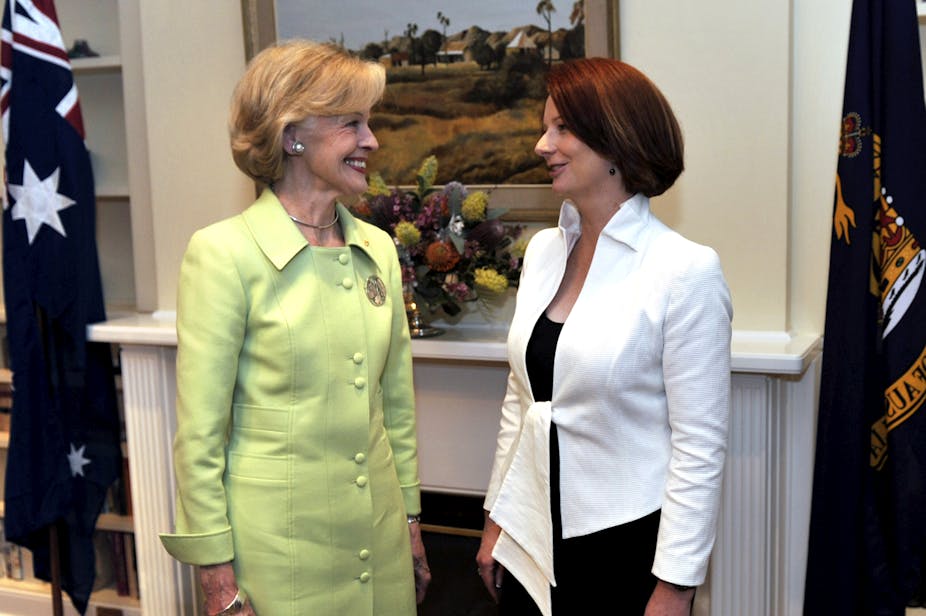From the time the carbon tax policy was unveiled in February 2011 until its implementation on July 1, the unchallenged consensus of the Canberra press gallery was that a Tony Abbott prime ministership was simply a matter of time.
Polling certainly provided a temptation to succumb to such a view, with Labor recording such lows with such consistency as no past government had ever recovered from – at least within the limited frame provided by the modern era of opinion polling, which has seen only five changes of government. State election disasters in New South Wales and Queensland likewise suggested that Labor was unmooring from its support base as never before.
Not for the first time though, the self-confidence of political commentators, together with the utility of mid-term polling as a pointer to outcomes at long range, has been shown to have been greatly exaggerated.
As the Prime Minister and her defenders had long forecast, the introduction of the carbon tax has heralded a shift in the political breeze, such that current polling offers no basis for predicting the result with any confidence one way or the other.
The press gallery has generally been reluctant to relax its assumptions so far, although suggestions that the Coalition might achieve something close to a senate majority have quietly disappeared. Labor, however, will be allowing itself to view the future through a hopeful eye, and planning its election strategy on a basis of playing to win. To do so it must achieve something which remains off the radar for observers still wedded to the old assumptions: gaining seats from the Coalition.

To the extent that anything in politics can be safely assumed, there seems little prospect that Labor will again enjoy support in the next parliament from representatives for New England and Lyne, presently held by its independent backers Tony Windsor and Rob Oakeshott.
On the other hand, Labor looks well placed to win Melbourne from Adam Bandt of the Greens, and might also hope to recover the Hobart-based seat of Denison from the surprise victor of 2010, Andrew Wilkie. However, since both seem unlikely to ever vote down a Labor government on confidence or supply, that does not alter the basic calculus for retaining government.
Labor will thus need a bare minimum net gain of two seats to again govern in minority, and another two again if it is to go one better. The question thus arises as to which areas it might most profitably target.
Having warned the reader off investing too much in predictions, it behoves me to grant that my own capacity to project the electoral terrain a year hence is no greater than anybody else’s. Nonetheless, there are certain regional variations in the national picture which seem well established.
Clearly Labor will hope to gain from the severity of the Newman government’s cutbacks in Queensland, where the recent polling shift to Labor has been most pronounced. Whereas the expectation had been that only Kevin Rudd in Griffith would survive the looming backlash, more recent figures point to the loss of at most one or two out of eight seats.
If Labor can clear the low bar of having a better campaign than in 2010, it can entertain hopes of recovering some of the seats it lost – the most surprising of which was Brisbane, now held by the LNP on a margin of 1.1%. Two further metropolitan marginals, Forde (1.6%) and Bonner (2.8%), can also expect to be heavily targeted.

The Newman government might also prove an asset beyond the state border. A pointer to this was provided by the recent Northern Territory election, which reversed the traditional pattern in that Labor retained all its seats in Darwin while suffering a decisive backlash in remote areas.
Significantly, Darwin has the largest concentration of public servants of any city other than Canberra – and is accommodated federally by the seat of Solomon, which the Country Liberal Party gained from Labor in 2010 by a margin of 1.8%.
Polling throughout the current term has indicated relatively small swings against Labor in Western Australia, where net losses at three consecutive elections meant there was little further ground left to lose. That suggests opportunities in the demographically Labor-leaning eastern suburbs seats of Hasluck (0.6%) and Swan (2.5%).
In Victoria, the mounting unpopularity of the Coalition state government will inspire hopes of shaking loose two seats in Melbourne east and south-east which narrowly held out against swings to Labor in 2010: Aston, where redistribution has further garnished the Liberal margin from 1.8% to 0.7%, and Dunkley, where the margin is 1.1%.
Amid a more optimistic picture nationally, New South Wales remains Labor’s Achilles’ heel. It is in suburban Sydney that the ongoing political headache of asylum seekers is most problematic, and also where the media environment facing the government is most hostile.
Most troubling for Labor, it is home to a brace of seats where its margins were cut fine in 2010: Greenway (0.9%), Banks (1.4%), Reid (2.7%), Parramatta (4.4%) and the fabled crucible of its 2010 election strategy, Lindsay (1.1%).
It would be supremely wrong headed to claim Labor is poised to win re-election in 2013, but it would be equally short-sighted to deny the possibility altogether.

